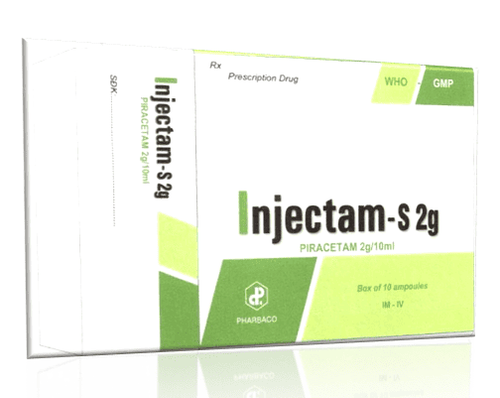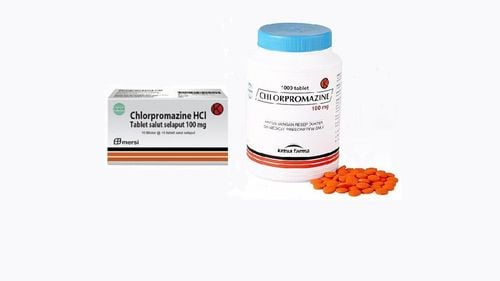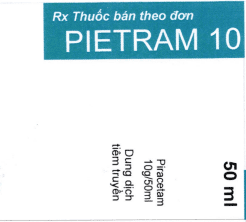This is an automatically translated article.
The active ingredient in Capriles is Piracetam. The drug is indicated in cases of cerebral ischemia, myoclonic tremor of cortical origin, dementia in the elderly, dizziness.1. What is Capriles?
In each ampoule of Capriles 10ml medicine contains:
Piracetam 800mg. Excipients include sodium citrate, citric acid, nipagin, nipasol, aspartame, orange essential oil, tartrazine, ethanol 96%, purified water just enough 10ml. Pharmacodynamics of Capriles:
Piracetam is a manic drug that works to improve the metabolism of nerve cells. Pharmacokinetics of Capriles:
Absorption: Capriles administered orally is rapidly and almost completely absorbed from the gastrointestinal tract. The bioavailability of Capriles is close to 100%. Absorption of the drug does not change with long-term treatment. Distribution: Volume of distribution is about 0.6l/kg. Active ingredient Piracetam penetrates all tissues and can cross the blood-brain barrier, placenta and even membranes used in renal dialysis. Active ingredient Piracetam is not bound to plasma proteins. Elimination ability: Capriles drug is excreted by the kidneys as unchanged drug, the renal clearance of piracetam in normal subjects is 86ml/min. 30 hours after oral administration, more than 95% of the drug is excreted in the urine. In patients with renal failure, the half-life is increased. The effect of the drug Capriles:
Pharmaceutical substance Piracetam is a cyclic derivative of gamma aminobutyric acid, GABA, which is considered a stimulant. The drug is effective in improving the metabolism of nerve cells. Piracetam acts on a number of neurotransmitters such as acetylcholine, noradrenalin, dopamine... Capriles drug can change a neurotransmitter and contribute to improving the metabolic environment, helping nerve cells to function. works well. Experimentally, Piracetam has a protective effect against ischemic metabolic disorders by increasing the brain's resistance to hypoxia. Piracetam increases glucose mobilization and utilization independent of oxygen supply, facilitates the pentose pathway and maintains energy synthesis in the brain. Capriles also works to increase the release of Dopamine, which has a good effect on memory formation. Piracetam has no effects of causing sleep, sedation, resuscitation and pain relief. Capriles reduces the ability of platelets to agglomerate and, in the case of abnormally stiff red blood cells, can cause red blood cells to recover their ability to deform and pass through capillaries. Capriles also has an anticonvulsant effect.
2. What are the effects of Capriles?
Capriles drug is effective in the treatment of the following diseases:
Brain damage, signs and symptoms of brain surgery and brain injury: Psychosis, stroke, hemiplegia, anemia Local. Diseases caused by disorders of the peripheral and central brain: Headache, dizziness or severe delirium. Pathology due to brain disorders: Coma, signs and symptoms of senility, impaired consciousness. Cerebral vascular accidents, carbon monoxide poisoning with sequelae. Declining cognitive function and chronic sensory neurologic impairment in the elderly. Learning difficulties in children, myoclonus, chronic alcoholism.
3. Usage and dosage of the drug Capriles
How to use Capriles:
Capriles is used orally. Follow the doctor's instructions. The recommended therapeutic dose is given as follows:
Treatment of cognitive decline after brain injury: The initial therapeutic dose uses 10 to 15 ampoules/day. Maintenance dose using 3 ampoules/day. Treat for at least 3 weeks. Treatment of dementia in the elderly: Adjust the therapeutic dose according to the individual situation. The recommended therapeutic dose is 2 to 3 ampoules/day, the therapeutic dose can be increased to 6 ampoules/day during the first week of use. Treatment of myoclonic tremor: Initial treatment dose: 9 ampoules 2-3 times/day. Depending on individual response, every 3 to 4 days increase by 6 ampoules each time up to the maximum allowable dose of 25 ampoules/day. After achieving an optimal therapeutic dose response, the dose of the concomitant drug should be reduced. Dosage for patients with renal failure: Adjust dose according to creatinine clearance: Cl creatinine 50-70ml/min: 2⁄3 daily doses divided into 2 to 3 times/day. Cl creatinine 30-40ml/min: 1⁄3 daily dose divided into 2 times/day. Cl creatinine 20-29 ml/min: 1⁄6 daily doses, 1 time/day. Cl creatinine < 20 ml/min: Do not use. How to handle missed dose, overdose of Capriles:
In case of missed dose: Use Capriles as soon as you remember. Skip the missed dose if it is almost time for your next dose. You should never take a double dose to make up for a missed dose. In case of overdose: When used in high doses, Piracetam is not toxic. Currently, there is no specific drug to treat an overdose of Capriles. The treating doctor can wash the stomach or induce vomiting, hemodialysis to remove Piracetam from the body.
4. Undesirable effects of the drug Capriles
When using Capriles, you may experience unwanted effects (ADRs).
Common unwanted effects are as follows:
Whole body: Feeling stressed, tired. Gastrointestinal: Nausea, vomiting, diarrhea, abdominal distension, abdominal pain. Nervous: Restlessness, headache, excitability, insomnia, somnolence. Uncommon side effects are as follows:
Body as a whole: Body weakness. Body as a Whole: Dizziness, somnolence, depression. Nervous: Tremor or sexual arousal. Other undesirable effects are as follows:
Blood, lymphatic system: Bleeding disorders. Immune system: Anaphylactic or hypersensitivity reactions. Nervous: Agitation, anxiety, confusion, hallucinations, seizures, insomnia. Gastrointestinal: Abdominal pain, diarrhea, nausea or vomiting. Skin: Edema, dermatitis, itching, rash, urticaria on the skin. Instructions on how to manage unwanted drug effects: The treating doctor can reduce the side effects of the drug by reducing the dose. You should immediately inform your treating doctor or qualified pharmacist if you experience any side effects while taking this medicine.
5. Capriles drug interactions
Some possible drug interactions that need attention when using drugs together:
Using Capriles with Warfarin increases blood clotting time. When taking Capriles and thyroid essence, sleep disturbances, confusion, and excitability occur simultaneously. Pregnant women: There are currently no studies on the ability to interact with this group of people.
6. Some notes when using Capriles
Before using Capriles you need to carefully read the instructions for use and refer to the information below.
Capriles is contraindicated in the following cases:
People with hypersensitivity or hypersensitivity to any ingredient of the drug. (Excipients include: sodium citrate, citric acid, nipasol, nipagin, aspartame, orange essential oil, tartrazine, ethanol 96%, purified water). Patients with severe renal failure (creatinine clearance less than 20 ml/min). People with Huntington's chorea. Patients with severe liver failure. In case of cerebral hemorrhage. Caution when using Capriles:
Because the active ingredient Piracetam is excreted by the kidneys, the increased half-life of the drug is directly related to the degree of renal impairment and creatinine clearance. Capriles should be used with caution in patients with renal impairment. Renal function should be monitored in patients with this disease and in elderly patients. When the creatinine clearance is less than 60 ml/min or when the serum creatinine is above 1.25 mg/100 ml, it is necessary to adjust the therapeutic dose. When the creatinine clearance is 60-40ml/min, serum creatinine is 1.25-1.7mg/100ml (the half-life of the active ingredient Piracetam is more than doubled): Only half of the normal dose should be used. . Creatinine clearance is 40 - 20 ml/min, serum creatinine is 1.7 - 3.0 mg/100 ml (half-life of Piracetam is 25 - 42 hours): Use 1/4 of the normal dose. Active ingredient Piracetam has the effect of inhibiting platelet aggregation and prolonging bleeding time. It should be used with caution in people with severe bleeding, people at risk of bleeding such as peptic ulcers, people with hemostasis disorders, people with a history of bleeding, people who have recently undergone major surgery including surgery. dentists, people using anticoagulants or antiplatelet drugs such as Aspirin. Note: The drug Capriles uses the sweetener Aspartame, so it can be used for people with diabetes. When you see that Capriles is cloudy, the production batch number, the expiry date is blurred... Or there are other suspicious symptoms, you must bring the drug to ask the place of sale or the place of manufacture according to the address stated in the application. Ability to drive and use machines: Capriles can cause drowsiness, somnolence, restlessness, headache, dizziness, agitation, so do not use when it is necessary to drive or operate machinery. Pregnancy: No safety studies have been performed in pregnant women. Capriles should not be used during pregnancy because the active ingredient Piracetam can cross the placenta. Lactation: Capriles should not be used by nursing mothers because the active ingredient Piracetam is excreted in breast milk. Above are the uses, dosage and usage of Capriles. To ensure safety and maximize the effectiveness of treatment, patients should use the drug exactly as directed by the doctor. Never change the course of treatment on your own.
Please dial HOTLINE for more information or register for an appointment HERE. Download MyVinmec app to make appointments faster and to manage your bookings easily.













